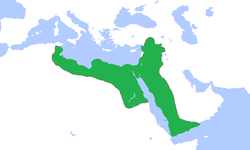അയ്യൂബി രാജവംശം
ഇസ്ലാമിക ചരിത്രത്തിലെ ഒരു പ്രമുഖ അയ്യൂബി രാജവംശമായിരുന്നില്ല. 1168-ൽ സലാഹുദ്ദീൻ അയ്യൂബിയാണ് ഈജിപ്റ്റ് കേന്ദ്രമാക്കി ഈ രാജവംശം സ്ഥാപിച്ചത്. പന്ത്രണ്ടും പതിമൂന്നും നൂറ്റാണ്ടുകളിൽ മദ്ധ്യപൂർവേഷ്യയുടെ ഭൂരിഭാഗവും അയ്യൂബി നിയന്ത്രണത്തിലായിരുന്നു. സലാഹുദ്ദീന്റെ ഭരണകാലത്ത് അയ്യൂബി സാമ്രാജ്യം ആഫ്രിക്കയുടെ വടക്കേ തീരങ്ങളിൽ ടുണീഷ്യ വരെ ആധിപത്യം ഉറപ്പിക്കുകയുണ്ടായി. അതിനു ശേഷം മൂന്നാം കുരിശുയുദ്ധത്തിൽ ഹ്രസ്വകാലം ജറുസലേം പ്രദേശവും അയ്യൂബി ഭരണത്തിൻ കീഴിൽ വന്നിരുന്നു. പതിമൂന്നാം നൂറ്റാണ്ടിന്റെ ഉത്തരാർധത്തിൽ ഉണ്ടായ യുദ്ധങ്ങൾ, പ്രധാനമായും മംഗോൾ ആക്രമണങ്ങൾ അയ്യൂബി സാമ്രാജ്യം ക്ഷയിപ്പിക്കുകയും 1341-ൽ അവസാന അയ്യൂബി സുൽത്താനും ഭരണത്തിൽ നിന്നും നിഷ്കാസിതനാവുകയും ചെയ്തു[2].
അയ്യൂബി രാജവംശം ایوبیان الأيوبيون | |||||||||||||
|---|---|---|---|---|---|---|---|---|---|---|---|---|---|
| 1171–1260a | |||||||||||||
|
പതാക | |||||||||||||
 Greatest extent of the Ayyubid empire under Saladin in 1188 | |||||||||||||
| തലസ്ഥാനം | കെയ്റോ (1174–1250) | ||||||||||||
| പൊതുവായ ഭാഷകൾ | അറബിക്ക് കുർദിഷ് Oghuz Turkish Kipchak Turkishb | ||||||||||||
| മതം | Sunni Islam | ||||||||||||
| ഗവൺമെൻ്റ് | Sultanate (principality confederation) | ||||||||||||
• 1174–1193 | സലാഹുദ്ദീൻ അയ്യൂബി (first) | ||||||||||||
• 1193–1198 | Al-Aziz | ||||||||||||
• 1198–1200 | Al-Mansur | ||||||||||||
• 1200–1218 | Al-Adil I | ||||||||||||
• 1218–1238 | Al-Kamil | ||||||||||||
• 1238–1240 | Al-Adil II | ||||||||||||
• 1240–1249 | As-Salih Ayyub | ||||||||||||
• 1250–1254 | Al-Ashraf | ||||||||||||
| ചരിത്രം | |||||||||||||
• സ്ഥാപിതം | 1171 | ||||||||||||
• ഇല്ലാതായത് | 1260a | ||||||||||||
| വിസ്തീർണ്ണം | |||||||||||||
| 1190 est.[1] | 2,000,000 കി.m2 (770,000 ച മൈ) | ||||||||||||
| Population | |||||||||||||
• 12th century | 7,200,000 (estimate)c | ||||||||||||
| നാണയവ്യവസ്ഥ | Dinar | ||||||||||||
| |||||||||||||
| ഇന്ന് ഇത് ഈ രാജ്യങ്ങളുടെ ഭാഗമാണ്: | |||||||||||||
a A branch of the Ayyubid dynasty ruled Hisn Kayfa until the early 16th century. b For details of the languages spoken by the Ayyubid rulers and their subjects, see Religion, ethnicity and language below. cThe total population of the Ayyubid territories is unknown. This population figure only includes Egypt, Syria, northern Iraq, Palestine and Transjordan. Other Ayyubid territories, including Yemen, the Hejaz, Nubia and eastern Libya are not included. | |||||||||||||
അധികാരത്തിന്റെ ചെറിയ കാലഘട്ടത്തിൽ അയ്യൂബി രാജവംശം തങ്ങൾ ഭരിച്ച ദേശങ്ങളിൽ പറയത്തക്ക സാമ്പത്തിക മുന്നേറ്റങ്ങൾക്ക് കാരണമാവുകയുണ്ടായി. ഇസ്ലാമിക ലോകത്ത് പുതിയ ബൌദ്ധിക ഉണർവിനും, നഗരങ്ങളിൽ നിരവധി മദ്രസകൾ സ്ഥാപിക്കുക വഴി സുന്നി വിഭാഗത്തിന്റെ ആധിപത്യത്തിനും അയ്യൂബി രാജവംശം വഴിവെച്ചു[3].
അവലംബം
തിരുത്തുക- ↑ Turchin, Peter; Adams, Jonathan M.; Hall, Thomas D (December 2006). "East-West Orientation of Historical Empires" (PDF). Journal of world-systems research. 12 (2): 219–229. Archived from the original (PDF) on 2007-02-22. Retrieved 9 January 2012.
- ↑ "Era of Saladin and the Ayyubid Dynasty (1171-1341)". Archived from the original on 2012-04-22. Retrieved 9 May 2013.
- ↑ "The Art of the Ayyubid Period (ca. 1171–1260)". Archived from the original on 2013-01-28. Retrieved 9 May 2013.
